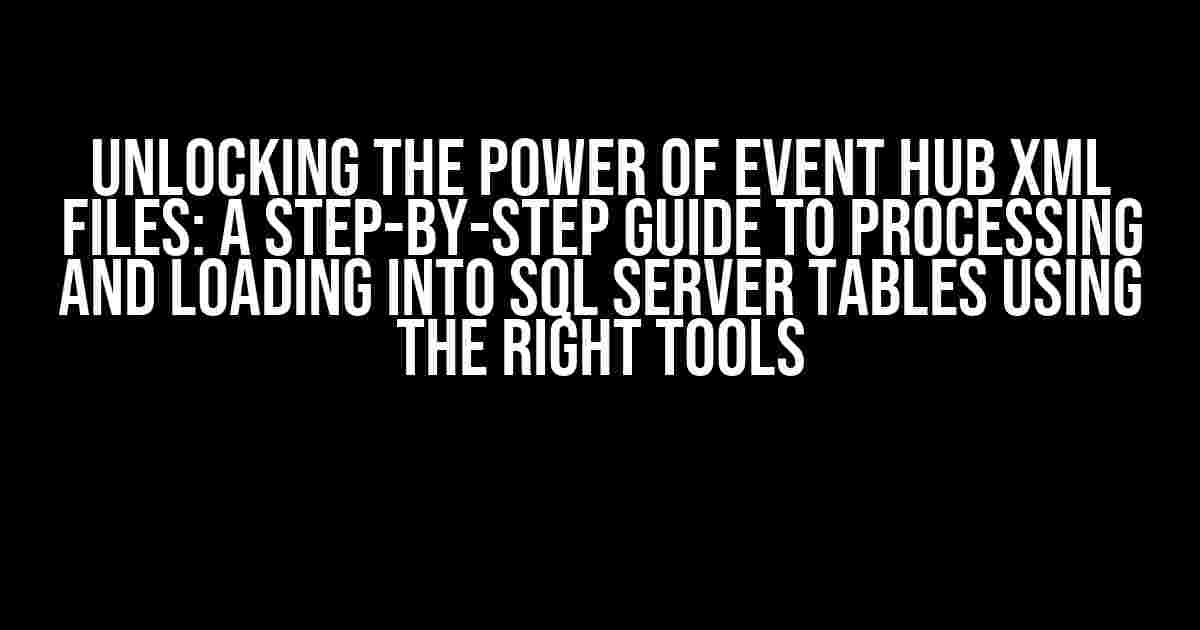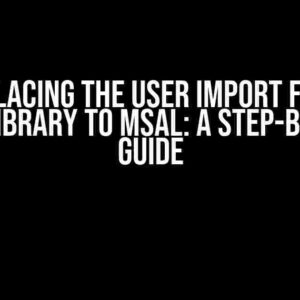Are you tired of dealing with the complexity of Event Hub XML files and struggling to extract valuable insights from them? Do you want to unlock the potential of your event data and load it into a SQL Server table for seamless analysis and reporting? Look no further! In this comprehensive guide, we’ll walk you through the process of processing Event Hub XML files and loading them into a SQL Server table using the right tools.
- Why Process Event Hub XML Files?
- The Right Tools for the Job
- Step 1: Create an Azure Event Hub and Configure Event Data Ingestion
- Step 2: Process Event Data using Azure Function
- Step 3: Configure Azure Data Factory (ADF) for Data Ingestion and Transformation
- Step 4: Load Transformed Data into SQL Server Table
- Step 5: Monitor and Analyze Event Data
- Conclusion
Why Process Event Hub XML Files?
Event Hub XML files contain a treasure trove of information, from application logs to IoT sensor data. However, extracting insights from these files can be a daunting task, especially when dealing with large volumes of data. By processing and loading Event Hub XML files into a SQL Server table, you can:
- Analyze event data in real-time
- Identify trends and patterns
- Improve application performance and reliability
- Enhance customer experiences
- Support data-driven decision-making
The Right Tools for the Job
To process and load Event Hub XML files into a SQL Server table, you’ll need the following tools:
- Azure Event Hubs: A fully managed, big data streaming platform for ingesting, processing, and analyzing event data.
- Azure Function: A serverless computing service for processing event data in real-time.
- Azure Data Factory (ADF): A cloud-based data integration service for extracting, transforming, and loading data.
- SQL Server Management Studio (SSMS): A comprehensive tool for managing and querying SQL Server databases.
- XSLT (Extensible Stylesheet Language Transformations): A language for transforming and processing XML files.
Step 1: Create an Azure Event Hub and Configure Event Data Ingestion
First, create an Event Hub namespace and event hub using the Azure portal. Configure your event hub to receive event data from your application or IoT devices.
az eventhubs namespace create --name --resource-group
az eventhubs eventhub create --name --namespace-name --resource-group
Step 2: Process Event Data using Azure Function
Create an Azure Function to process event data in real-time. Write a C# script to read event data from the Event Hub, transform it using XSLT, and output the transformed data to a JSON file.
using Microsoft.Azure.EventHubs;
using System.Xml.Xsl;
public static void Run(EventData[] events, ILogger logger)
{
foreach (var @event in events)
{
var xmlDoc = new XmlDocument();
xmlDoc.LoadXml(@event.Body.ToString());
var xslt = new XslCompiledTransform();
xslt.Load("transform.xsl");
var jsonOutput = "";
using (var sw = new StringWriter())
{
xslt.Transform(xmlDoc, null, sw);
jsonOutput = sw.ToString();
}
// Output transformed data to JSON file
logger.LogInformation($"Transformed event data: {jsonOutput}");
}
}
Step 3: Configure Azure Data Factory (ADF) for Data Ingestion and Transformation
Create an ADF pipeline to ingest the transformed JSON file, transform it further, and load it into a SQL Server table.
| Activity | Description |
|---|---|
| Copy Data | Ingest JSON file from Azure Blob Storage |
| Data Flow | |
| Copy Data | Load transformed data into SQL Server table |
Step 4: Load Transformed Data into SQL Server Table
Use ADF to load the transformed data into a SQL Server table. Create a SQL Server connection, define the target table, and configure the load settings.
CREATE TABLE [dbo].[EventHubData](
[Id] [int] IDENTITY(1,1) NOT NULL,
[EventDateTime] [datetime] NOT NULL,
[EventType] [nvarchar](50) NOT NULL,
[EventData] [nvarchar](max) NOT NULL
)
GO
Step 5: Monitor and Analyze Event Data
Use SQL Server Management Studio (SSMS) to monitor and analyze event data in real-time. Write T-SQL queries to extract insights, identify trends, and visualize data using SQL Server Reporting Services (SSRS).
SELECT
EventDateTime,
EventType,
EventData
FROM
[dbo].[EventHubData]
WHERE
EventDateTime >= DATEADD(hour, -1, GETDATE())
ORDER BY
EventDateTime DESC
Conclusion
In this comprehensive guide, we’ve shown you how to process Event Hub XML files and load them into a SQL Server table using Azure Event Hubs, Azure Function, Azure Data Factory, and SQL Server Management Studio. With the right tools and a clear understanding of the processing pipeline, you can unlock the full potential of your event data and drive business success.
Remember to optimize your pipeline for performance, scalability, and reliability, and to continuously monitor and analyze your event data to extract valuable insights.
Takeaway Tips
- Use Azure Event Hubs for real-time event data ingestion
- Employ Azure Function for event data processing and transformation
- Leverage Azure Data Factory for data ingestion, transformation, and loading
- Use SQL Server Management Studio for monitoring and analyzing event data
- Optimize your pipeline for performance, scalability, and reliability
Now, go ahead and unlock the power of your Event Hub XML files!
Frequently Asked Questions
Want to know the best tools for processing Event Hub XML files to SQL Server tables? We’ve got you covered! Check out our top picks below.
What is the most popular tool for processing Event Hub XML files to SQL Server tables?
Azure Data Factory (ADF) is the most popular tool for processing Event Hub XML files to SQL Server tables. It provides a scalable, secure, and reliable way to integrate data from various sources, including Event Hubs, and load it into SQL Server tables.
Can I use Apache NiFi for processing Event Hub XML files to SQL Server tables?
Yes, you can use Apache NiFi for processing Event Hub XML files to SQL Server tables. NiFi is a popular open-source data integration tool that supports various data sources, including Event Hubs, and can write data to SQL Server tables.
Is Microsoft Power Automate (formerly Microsoft Flow) suitable for processing Event Hub XML files to SQL Server tables?
Yes, Microsoft Power Automate can be used for processing Event Hub XML files to SQL Server tables. Although it’s primarily a workflow automation tool, Power Automate has connectors for Event Hubs and SQL Server, making it a viable option for simple data integration scenarios.
Can I use SQL Server Integration Services (SSIS) for processing Event Hub XML files to SQL Server tables?
Yes, you can use SQL Server Integration Services (SSIS) for processing Event Hub XML files to SQL Server tables. SSIS provides a robust and scalable way to integrate data from various sources, including Event Hubs, and load it into SQL Server tables.
Are there any open-source ETL tools that can process Event Hub XML files to SQL Server tables?
Yes, there are several open-source ETL tools that can process Event Hub XML files to SQL Server tables, such as Talend, Pentaho Data Integration, and Informatica PowerCenter. These tools provide a cost-effective alternative to commercial ETL tools and offer a range of features and functionalities for data integration.


